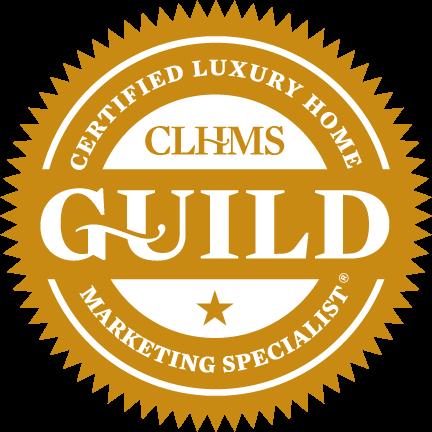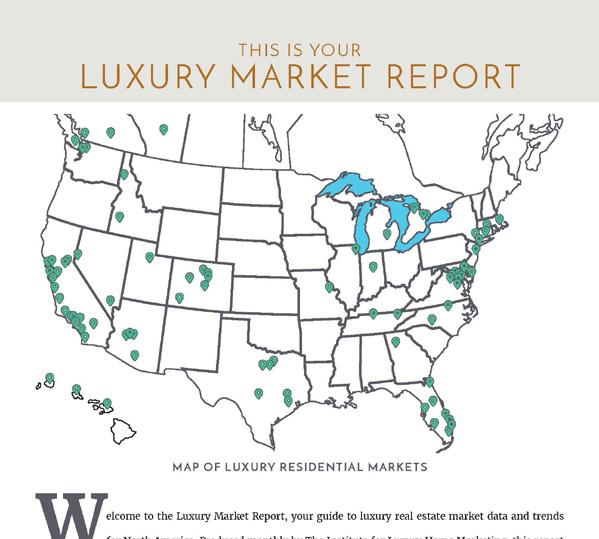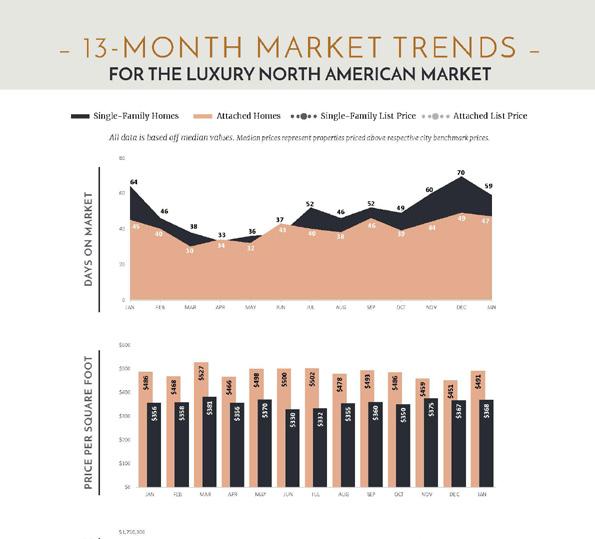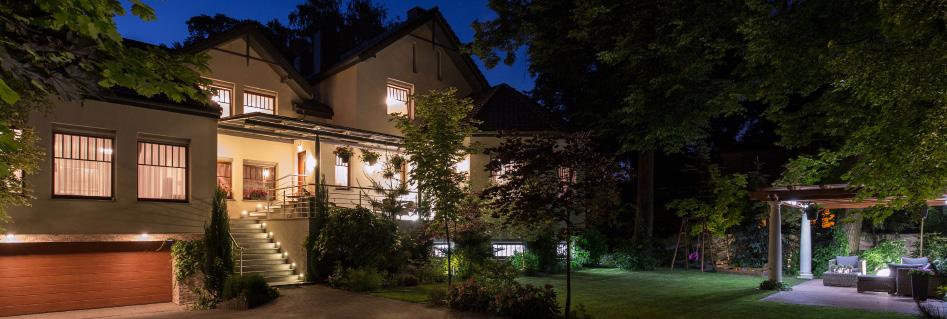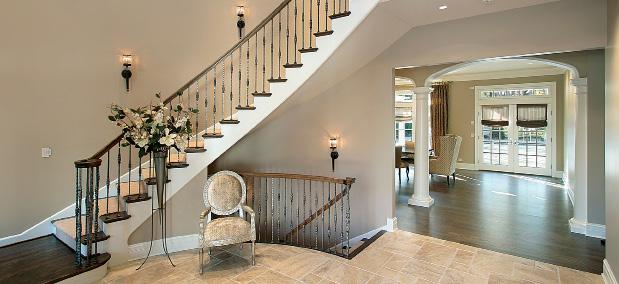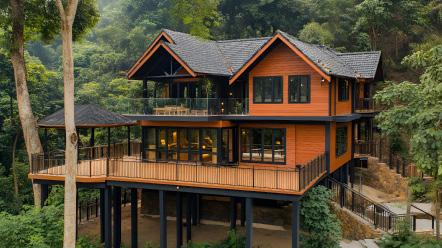NEW MARKET REALITIES
The luxury residential real estate market in 2025 has become a study in contrast.
Just months ago, the luxury market seemed poised for renewed momentum as long-awaited inventory finally began to hit the market after years of shortages. But in a swift turn, rising inventory hasn’t translated into the greatly anticipated volume of increased sales. Across North America and globally, the market is now defined less by a lack of supply and more by buyer hesitation driven by economic uncertainty.
In key U.S. markets like New York1 and Greenwich2, affluent buyers are in a holding pattern, contracts are being signed, but closings are delayed as buyers await stability in the stock market and interest rates.
Europe is showing similar signs, with Morgan Stanley Capital International reporting an 11% year-overyear drop in luxury property sales due to geopolitical instability and bond market volatility3.
In Canada, March 2025 saw the weakest sales performance for that month since 2009, with national home sales down 9.3% year-over-year and CREA revising its annual forecast downward sharply.
CREA’s senior economist cited tariff concerns and broader economic uncertainty as key causes of this stagnation4
Yet, in stark contrast, the Hamptons are booming. Sales have surged 85.5% year-over-year in Q1, and the median price broke $2 million for the first time—largely driven by confident buyers in the $1–$5 million range, signaling strength in the mid-tier luxury segment5.
In 2025, several New Jersey markets - including Monmouth County, Somerset Hills, and Short Hills - are seeing an uptick in luxury sales, driven by proximity to New York City, limited inventory, and continued demand from affluent buyers. Despite broader economic uncertainty, these areas stand out for their
1 https://nypost.com/2025/05/06/real-estate/nycs-trophy-market-of-10m-plus-homes-shows-signs-of-weakness/?utm_source=chatgpt.com
2 https://www.ctinsider.com/realestate/article/ct-greenwich-real-estate-contracts-2025-20286565.php?utm_source=chatgpt.com
3 https://www.reuters.com/business/finance/european-real-estate-recovery-thrown-off-course-by-trump-uncertainty-says-msci-2025-05-01/?utm_source=chatgpt.com
4 https://www.reuters.com/world/americas/canadian-home-sales-post-weakest-march-since-2009-tariff-uncertainty-2025-04-15/?utm_source=chatgpt.com
5 https://nypost.com/2025/04/25/real-estate/home-prices-in-the-hamptons-just-reached-a-record-high/?utm_source=chatgpt.com
Sustainability has become inseparable from luxury. Eco-consciousness is no longer a niche concern but a core value and one that also signals status. Homes are being built or retrofitted with solar panels, reclaimed materials, water-saving systems, and energy-efficient infrastructure, showing that environmental responsibility is both ethical and aspirational.
Amid all this, flexibility has emerged as a defining characteristic of modern luxury living. Spaces are expected to evolve with shifting needs - a home office becomes a guest suite, a media room converts to a wellness studio. Modular furniture, adaptable layouts, and movable walls make multifunctionality both practical and stylish.
Ultimately, luxury in 2025 is about balance, between nature and innovation, wellness and performance, individuality and intelligence. It’s a design philosophy shaped not just by how a space looks, but how it lives.
HEADWINDS AND SHIFTS IN LUXURY HOME BUILDING
Despite the innovation on the design side, the economic backdrop for luxury homebuilding is challenging. Builders are contending with sharply rising costs, particularly due to tariffs on key imported materials like Canadian lumber and steel. According to Investopedia6, these tariffs alone have added an average of $10,900 to the price of a new home in the U.S.
At the same time, elevated mortgage rates, hovering above 6%, and broader economic uncertainty have reduced the pool of buyers able or willing to take on large-scale new builds. This decline in buyer confidence is reflected in builder sentiment as well. The National Association of Home Builders (NAHB) reports that its Housing Market Index fell to 42 in February 2025, the lowest it’s been in five months.7
Labor shortages further complicate the equation. Skilled trades like carpentry, electrical, and masonry remain in short supply, lengthening timelines and raising costs. Meanwhile, supply chain disruptions
6 https://www.investopedia.com/trump-s-first-100-day-actions-that-have-affected-your-wallet-11724171?utm_source=chatgpt.com
7 https://www.ncconstructionnews.com/builder-confidence-drops-to-seven-month-low-nahb-wells-fargo-housing-market-index-shows/
persist, making it more difficult to source materials and complete projects on schedule.
These pressures are prompting a strategic pivot within the industry. Rather than taking on the financial and operational risks of new construction, many builders and developers are shifting their focus to renovations. The NAHB forecasts strong growth in the remodeling sector in 2025, driven by aging housing stock, high homeowner equity, and a growing preference among consumers to upgrade existing homes rather than build new ones.
Remodeling projects offer a more controlled, lower-risk path in a volatile market. They also align well with current design trends, allowing homeowners to bring wellness features, smart technology, and sustainable materials into the homes they already love—without the cost or complexity of starting from scratch.
In the end, luxury residential real estate in 2025 is being reshaped by both aspiration and adaptation. While the desire for thoughtful, wellness-oriented living is stronger than ever, the realities of construction economics are pushing the industry toward renovation, reinvention, and resourcefulness. The result is a market where the most luxurious homes may not be the newest, but the most intelligently reimagined.
IN CONCLUSION
Working with a trusted luxury property specialist is key to gaining insight into what’s truly happening in your local market.
The art of buying and selling in this environment demands a critical and analytical approach. Setting realistic expectations and staying grounded in current realities will help ensure your goals are met with confidence and clarity.
A Review of Key Market Differences Year over Year
April 2024 | April 2025
1,139 Total
696
• Official Market Type: Balanced Market with a 18.00% Sales Ratio 1
• Attached homes are selling for an average of 98.92% of list price.
• The median luxury threshold2 price is $700,000, and the median attached luxury sale price is $879,000
• Markets with the Highest Median Sales Price: Park City ($3,362,500), Lake Tahoe, CA ($3,055,000), Pitkin County ($2,725,000), and San Francisco ($2,675,000).
• Markets with the Highest Sales Ratio: Howard County, MD (229.6%), Fairfax County, VA (108.3%), Arlington & Alexandria, VA (78.5%), and Anne Arundel County, MD (77.4%).
2025
SINGLE - FAMILY HOMES
LUXURY INVENTORY VS. SALES | APRIL 2025 Buyer's
$20,000,000+
$15,000,000 - $19,999,999
$10,000,000 - $14,999,999
$9,000,000 - $9,999,999
$8,000,000 - $8,999,999
$7,000,000 - $7,999,999
$6,000,000 - $6,999,999
$5,000,000 - $5,999,999
$4,000,000 - $4,999,999
$3,500,000 - $3,999,999
$3,000,000 - $3,499,999
$2,800,000 - $2,999,999
$2,600,000 - $2,799,999
$2,500,000 - $2,599,999
$2,400,000 - $2,499,999
MEDIAN
Luxury Benchmark Price 1: $1,275,000
13 - MONTH LUXURY MARKET TREND 4
Median Sales Price Inventory
Solds
MEDIAN DATA REVIEW | APRIL
• The attached luxury market is a Buyer's Market with a 10% Sales Ratio
• Homes sold for a median of 93.81% of list price in April 2025.
• The most active price band is $1,800,000-$1,899,999, where the sales ratio is 27%.
• The median luxury sales price for attached homes is $2,125,000.
• The median days on market for April 2025 was 66 days, up from 31 in April 2024.

